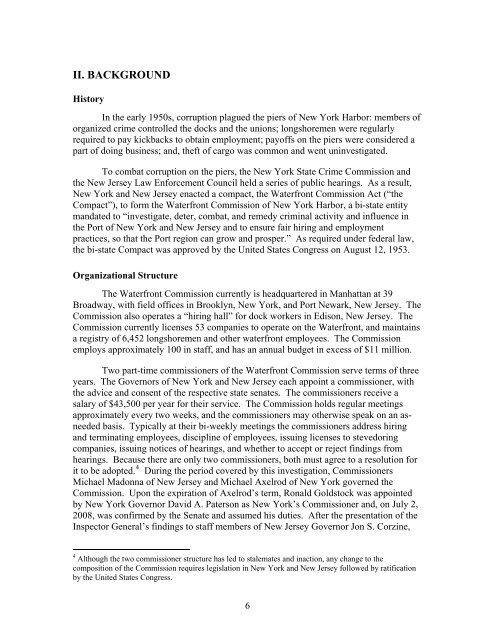Investigation of the Waterfront Commission of New York Harbor
Investigation of the Waterfront Commission of New York Harbor
Investigation of the Waterfront Commission of New York Harbor
You also want an ePaper? Increase the reach of your titles
YUMPU automatically turns print PDFs into web optimized ePapers that Google loves.
II. BACKGROUNDHistoryIn <strong>the</strong> early 1950s, corruption plagued <strong>the</strong> piers <strong>of</strong> <strong>New</strong> <strong>York</strong> <strong>Harbor</strong>: members <strong>of</strong>organized crime controlled <strong>the</strong> docks and <strong>the</strong> unions; longshoremen were regularlyrequired to pay kickbacks to obtain employment; pay<strong>of</strong>fs on <strong>the</strong> piers were considered apart <strong>of</strong> doing business; and, <strong>the</strong>ft <strong>of</strong> cargo was common and went uninvestigated.To combat corruption on <strong>the</strong> piers, <strong>the</strong> <strong>New</strong> <strong>York</strong> State Crime <strong>Commission</strong> and<strong>the</strong> <strong>New</strong> Jersey Law Enforcement Council held a series <strong>of</strong> public hearings. As a result,<strong>New</strong> <strong>York</strong> and <strong>New</strong> Jersey enacted a compact, <strong>the</strong> <strong>Waterfront</strong> <strong>Commission</strong> Act (“<strong>the</strong>Compact”), to form <strong>the</strong> <strong>Waterfront</strong> <strong>Commission</strong> <strong>of</strong> <strong>New</strong> <strong>York</strong> <strong>Harbor</strong>, a bi-state entitymandated to “investigate, deter, combat, and remedy criminal activity and influence in<strong>the</strong> Port <strong>of</strong> <strong>New</strong> <strong>York</strong> and <strong>New</strong> Jersey and to ensure fair hiring and employmentpractices, so that <strong>the</strong> Port region can grow and prosper.” As required under federal law,<strong>the</strong> bi-state Compact was approved by <strong>the</strong> United States Congress on August 12, 1953.Organizational StructureThe <strong>Waterfront</strong> <strong>Commission</strong> currently is headquartered in Manhattan at 39Broadway, with field <strong>of</strong>fices in Brooklyn, <strong>New</strong> <strong>York</strong>, and Port <strong>New</strong>ark, <strong>New</strong> Jersey. The<strong>Commission</strong> also operates a “hiring hall” for dock workers in Edison, <strong>New</strong> Jersey. The<strong>Commission</strong> currently licenses 53 companies to operate on <strong>the</strong> <strong>Waterfront</strong>, and maintainsa registry <strong>of</strong> 6,452 longshoremen and o<strong>the</strong>r waterfront employees. The <strong>Commission</strong>employs approximately 100 in staff, and has an annual budget in excess <strong>of</strong> $11 million.Two part-time commissioners <strong>of</strong> <strong>the</strong> <strong>Waterfront</strong> <strong>Commission</strong> serve terms <strong>of</strong> threeyears. The Governors <strong>of</strong> <strong>New</strong> <strong>York</strong> and <strong>New</strong> Jersey each appoint a commissioner, with<strong>the</strong> advice and consent <strong>of</strong> <strong>the</strong> respective state senates. The commissioners receive asalary <strong>of</strong> $43,500 per year for <strong>the</strong>ir service. The <strong>Commission</strong> holds regular meetingsapproximately every two weeks, and <strong>the</strong> commissioners may o<strong>the</strong>rwise speak on an asneededbasis. Typically at <strong>the</strong>ir bi-weekly meetings <strong>the</strong> commissioners address hiringand terminating employees, discipline <strong>of</strong> employees, issuing licenses to stevedoringcompanies, issuing notices <strong>of</strong> hearings, and whe<strong>the</strong>r to accept or reject findings fromhearings. Because <strong>the</strong>re are only two commissioners, both must agree to a resolution forit to be adopted. 4 During <strong>the</strong> period covered by this investigation, <strong>Commission</strong>ersMichael Madonna <strong>of</strong> <strong>New</strong> Jersey and Michael Axelrod <strong>of</strong> <strong>New</strong> <strong>York</strong> governed <strong>the</strong><strong>Commission</strong>. Upon <strong>the</strong> expiration <strong>of</strong> Axelrod’s term, Ronald Goldstock was appointedby <strong>New</strong> <strong>York</strong> Governor David A. Paterson as <strong>New</strong> <strong>York</strong>’s <strong>Commission</strong>er and, on July 2,2008, was confirmed by <strong>the</strong> Senate and assumed his duties. After <strong>the</strong> presentation <strong>of</strong> <strong>the</strong>Inspector General’s findings to staff members <strong>of</strong> <strong>New</strong> Jersey Governor Jon S. Corzine,4 Although <strong>the</strong> two commissioner structure has led to stalemates and inaction, any change to <strong>the</strong>composition <strong>of</strong> <strong>the</strong> <strong>Commission</strong> requires legislation in <strong>New</strong> <strong>York</strong> and <strong>New</strong> Jersey followed by ratificationby <strong>the</strong> United States Congress.6


